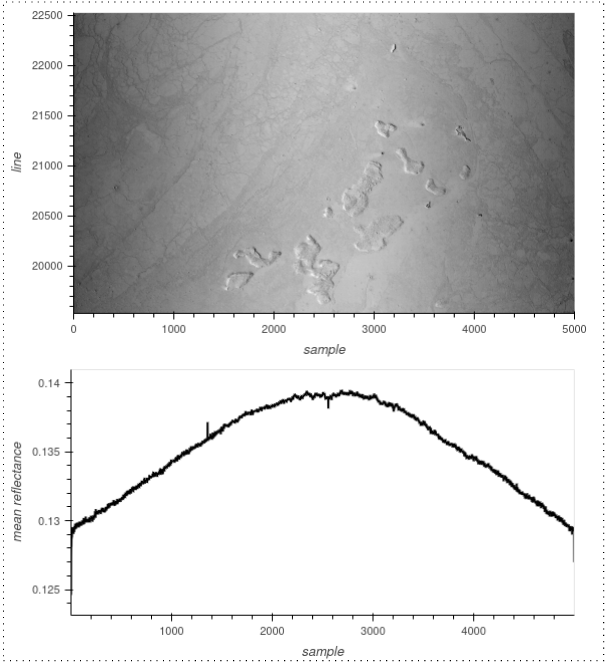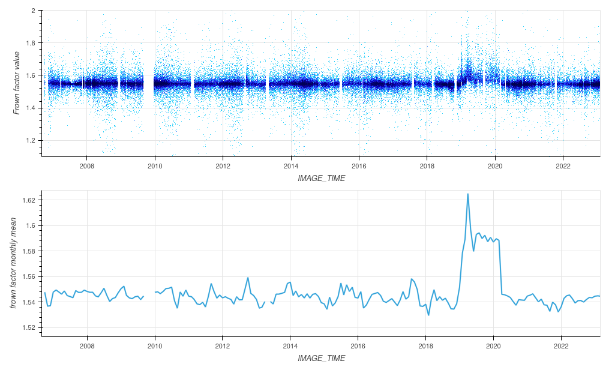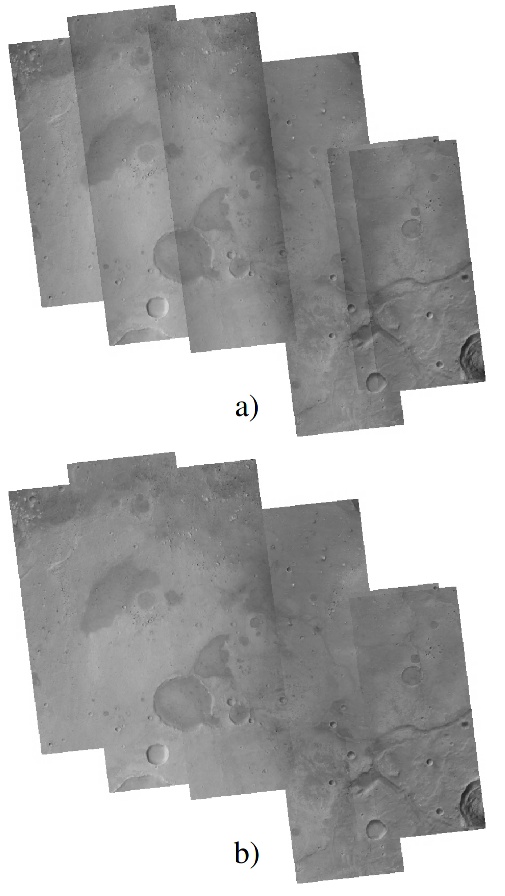Mars Reconnaissance Orbiter Context Camera updated in-flight calibration
- Freie Universität Berlin, Institute of Geological Sciences, Planetary Sciences and Remote Sensing, Berlin, Germany (sebastian.walter@fu-berlin.de)
Introduction: The Context Camera (CTX) has so far delivered more than 145,000 images [1]. The images are one of the most popular datasets for planetary geologists, providing extensive coverage, excellent radiometric resolution, and a unique resource for interpreting surface features. The Integrated Software for Imagers and Spectrometers (ISIS) is a software to support the ingestion, processing and analysis of planetary image data [2] and is the standard processing framework for CTX. Since the beginning of its mission, calibrated images from CTX have shown a subtle darkening effect from the centre of the image towards the edges. Due to its typical shape when plotted as a profile, this effect has been called the "frown" effect (see Figure 1).

Figure 1: Subset of CTX image G09_021566_1800 after nominal ISIS calibration together with a plot of the reflectance values averaged over all lines [3].
Some authors assume a varying darkening effect over the mission time, and workarounds to correct for this have been described [4,5]. Here we present an updated flat-field calibration for ISIS that removes the edge darkening effect. We ensure that it does not introduce any artefacts and perform quantitative validation of calibrated images to show the validity of the improvements.
Methods: The overall shape of the CTX flat-field is a curve, where the difference between the centre and the edges of the detector represents a quantifiable amount of darkening caused by lens vignetting. To quantify the amount of this edge darkening correction by a flat-field, we use the concept of the frown factor. Similar to the quantification of the band depth feature in spectral analysis, the amount of darkening correction by a flat-field can be expressed as the ratio of the mean values of the central area of the flat field to the mean values of its edges (see Figure 2).
Figure 2: Elements for the composition of the frown factor of a flat-field [3].
Before building a flat-field from a pool of input images, we correct the input data from bias and dark-current effects without any initial flat-field correction. As the ISIS ctxcal command combines these two corrections, we turn off the flat-field correction in ctxcal by providing a custom flat-field file where all values are set to one. We use the resulting pre-processed bias/dark-current corrected files for calculating the new flat-field.

Figure 3: Top: Scatter plot of the frown factor over time. Bottom: mean monthly frown factor over time [3].
Results: Figure 3 shows the temporal evolution and distribution of the frown factor, i.e. the amount of darkening towards the detector edges. We exclude images exhibiting overexposure or the ones with negative reflectance values after calibration. The frown factor remains relatively consistent around its mean of 1.55 until the end of 2018, followed by a subsequent rise until early 2020. Throughout this interval, the average frown factor for all images rises to approximately 1.6, and throughout 2020, it reverts to the value observed before the mentioned change.
Investigating the distribution of the frown factor excluding images from the problematic year 2019, we observe a skewed data distribution (Figure 4 right). As the frown factor outside the irregular time interval from 2019 until early 2020 appears very stable, we can safely assume that the edge-darkening effect is stable over time. The deviation from its mean during the period in question is not representative, as the central limit theorem is not fulfilled, which we observe in its non-symmetrical distribution.
Figure 4: Kernel density plot of the frown factor of all images except the ones from the year 2019 (left) compared with the ones from year 2019 (right) [3].
Evaluation: One of the main advantages of the improved calibration is better in-image stability for image mosaicking, which leads to homogeneous mosaics. An example of this is provided in Figure 5. The seams between adjacent images are strongly visible in the "before" mosaic (case a), processed with the nominal flat-field in ISIS. Using our new flat-field calibration file, most seams are no longer visible (case b).

Figure 5: Example CTX mosaic of the Oxia Planum region. Images were chosen from Martian Year 33. a) calibrated with the nominal ISIS internal flat-field calibration – b) calibrated with the new global flat-field calibration [3].
For a quantitative evaluation, we randomly chose 10.000 images over the full timespan and calibrated them with our new flat-field file when using ctxcal. The arithmetic mean of the frown factor of these images is then 1.00, proving a very good result and confirming the frown factor as a good quantification. We randomly reduced the subset to 1.000 images and performed a systematic visual inspection for qualitative evaluation. We could not find any signs of a remaining edge-darkening effect during the visual investigation. The residual edge-darkening effect is 1.079, calculated as the arithmetic mean over the individual factors of all images from the validation dataset calibrated with the previous flat-field file. This means, a surface recflectance measurement taken at the edge of a CTX image appears 8% darker than in the center, when calibrated with the previously available flat-field file.
The new flat-field calibration file is available from this data repository: http://dx.doi.org/10.17169/refubium-41645. It has also been provided to the ISIS development team in order to publish it in their default data directory, beginning with ISIS version 9.0.
Acknowledgements: This work is supported by the German Space Agency (DLR Bonn), grant 50 OO 2204, on behalf of the German Federal Ministry for Economic Affairs and Energy.
References: [1] M. C. Malin et al., JGR Planets (2007). [2] Jason Laura et al., 2023, DOI: 10.5281/zenodo.2563341. [3] Walter, et al., ESS 11 (2024), DOI: 10.1029/2023EA003491. [4] J. L. Dickson et al., LPSC 49 (2018), #2480. [5] Stuart J. Robbins et al., ESS 10 (2020).
How to cite: Walter, S., Aye, M., Jaumann, R., and Postberg, F.: Mars Reconnaissance Orbiter Context Camera updated in-flight calibration, Europlanet Science Congress 2024, Berlin, Germany, 8–13 Sep 2024, EPSC2024-77, https://doi.org/10.5194/epsc2024-77, 2024.